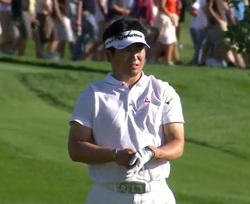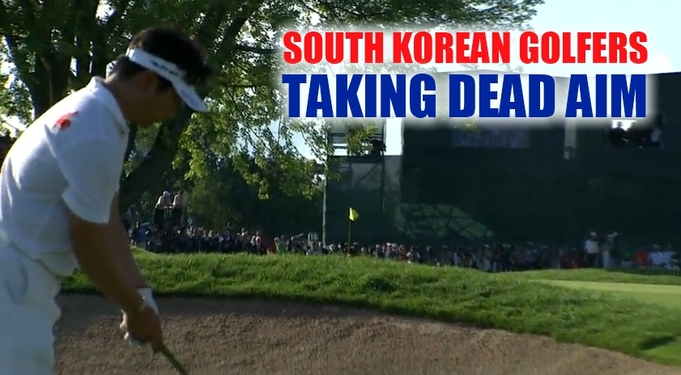|
Presently there are thirty eight Korean women golfers ranked in the top 100 on the LPGA tour, and four of them are in the top ten World Golf Rankings. Competing on the LPGA tour the number is approaching fifty, and thirty of them have won 100 tournaments and ten Majors. Not a bad record since 1998 and a country that has 0.7% of the world's population. The men are also stamping their authority on the USPGA Tour with five in the top 100 World Rankings (K.J. Choi, Y.E.Yang, Noh Seung Yul, Sang Moon Bae, Sunghoon Kang). The pathfinder has been K.J. Choi and the flood gates were opened when Y. E. Yang became the 1st Asian to win a Major (2009 USPGA) beating Tiger Woods on the final day at Hazeltine.  The most common perception or indeed belief is that it has happened out of the blue - a recent phenomenon over the last few years. But nothing could be further from the truth. It’s the culmination of a twenty year development plan that has come to fruition, and it happened because all stakeholders came together on the same page driving the Korean National Golf Program toward their “Goal.” In a country were higher education is placed above everything else for a young boy or girl. It is such a high priority that on one day in November (November 10th last year) the whole of South Korea comes to a halt and goes silent, aircraft are grounded, offices open later and commuters stay off the road so that final year high school students can take their final exams (multiple choice questions) that will literally determine their future. Score well and entry into the top universities of your choice wait for you, score badly and entry into university is not an option. The Beginning of Golf in South Korea  It all started when South Korea were awarded and hosted the Summer Olympic Games in 1988. Sport was almost elevated to the same level as education in the minds of most Koreans. School children attend school from 7 a.m. to 3 p.m. and to stay ahead of the pack their parents spend a substantial amount of their take home wages on private tuition (up to 3 hours extra each day) to ensure their child succeeds. It’s full on pressure and it becomes a way of life.  So the number one ingredient is the South Korean culture which emphasises constant repetition in pursuit of perfection and which Calligraphers and Taekwondo masters train their students. The conflict with educators in the Western World now is the argument between rote learning vs critical thinking. The Korean model leans toward rote learning which is learning things by repeating them without thinking of them or trying to understand them. Combined this with “deliberate practice” routines (K Anders Ericsson book “The Road to Excellence”) and a work ethic that most young westerner's (except Olympians and high achievers) would cringe at, and you have a recipe for success. Alright, we have the culture and the work ethic but this is where the stakeholders come in to make the South Korean golf program world class. Lawrie and I define world class in golf as Top 100 in the World Rankings. The stakeholders being Corporate Sponsors (LG, Samsung, Hyundai etc.), South Korean Golf Association, golf facilities (courses and driving ranges), golf coaches and most importantly Dad’s and Mum’s. The Great Migration of South Korean Golfers?  Here are some figures on the facilities and coaching available in South Korea. There are 500 golf courses, 4,000 driving ranges and 9,000 certified instructors. Now these numbers especially the certified instructors are critical to attract and develop world class golfers. What no one talks about is that for at least two months of the year winter sets in and playing golf is out of the question. So for the months of December to the end of February thousands of young Koreans with their instructors relocate to training venues all around South East Asia, Australia, New Zealand and the USA. In groups of up to 30 students they find a facility that allows them to hit unlimited golf balls and play 36 holes each day. Australia was a popular venue through the 90's and not just for the facility and climate but for the expertise in coaching, sports science and medicine that was available. These resources once exploited, these groups move on to more cost effective locations mainly in S.E. Asia.  What also happens is that whole family’s relocate to USA, Australia and New Zealand to further the careers of female golfers. The current US Junior and US Women Amateur Champions are Lee Minjie and Lydia Ko. Both of Korean heritage and live in Perth Western Australia and New Zealand respectively. The coming out for the South Koreans was when the women’s national team finished 2nd in the Espirito World Team Championship held in France in 1994. The youngest team member and 16 year old at the time shot a 64 in the last round and her name Se-Ri-Pak. (My business partner at Pro Tour Golf College Lawrie Montague was in Paris at that tournament as the Australian Women's Team Coach and witnessed her historic round) Four years later she made history by winning the 1998 US Women’s Open at Blackwolf Run and herald the coming Korean Juggernaut. At the last count she has won 5 Majors and 25 LPGA tournaments. It is widely known that her father was a hard task master who made his daughter each morning at 5.30 am run up and down 15 flights of stairs in their apartment block to build Se-Ri’s strength and cardio endurance. There were reports that in the early days he made her practice in the cold until icicles formed in her hair, and to toughen her up he made her sleep in a cemetery to overcome her nerves!! This is not the exception, but the rule for most parents who demand 100% commitment from their children.  The domination of South Korean women in Amateur team events in recent times was on show when they won the last Espirito World Amateur Team Championship in 2010 by 17 strokes from the USA, and the last Asia Pacific Team Championship (Queen Sirikit) by 15 shots. The men are now moving toward doing what the women did in the USA in the 1990’s as they are targeting the PGA Tour rather than the Japanese and Asian Tour as in years gone past. Five years ago 22 players signed up for the USPGA Tour school, last year 52 players signed up for Tour School. So it’s not good luck or “talent” as we get told but a twenty year plan that was conceived in the early 1990’s and followed exactly with no short cuts, and countless hours of practice and training by thousands of golfers to come to this point where South Koreans are the dominant force in Women’s golf and they're on-track for men's golf as well. SO THEY’RE NOT DONE YET!! The pipeline is filled up and ready to deliver the next generation of Champions. David Milne & Lawrie Montague - Pro Tour Golf College The Professional Golf Tour Training College for Serious Amateur Golfers 23/8/2012 09:49:47 pm
Nice description about the PGA tour of the golf. I think people should like it . I like this information too and also i am waiting for some new updates. Comments are closed.
|
Archives
June 2019
|
Proudly Supported By
Copyright © 2011 - 2018 Pro Tour Golf College
Website Managed By Golf Performance Media
All Rights Reserved
Website Managed By Golf Performance Media
All Rights Reserved




 RSS Feed
RSS Feed



